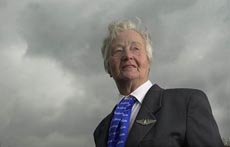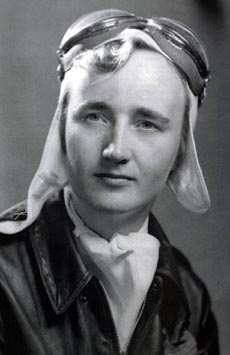| Pittsburgh, PA Friday November 15, 2002 |
 |
| News Sports Lifestyle Classifieds About Us | |
|
|
|
|
|
Women Airforce Service Pilots put sting in war effort Monday, November 11, 2002 By Cindi Lash, Post-Gazette Staff Writer
Florence Shutsy-Reynolds wasn't out of grade school when she sat down
to supper one night and announced to her family her intention to learn to
fly.
"They all laughed," she said, grinning at the 70-year-old memory. "I
wasn't laughing."
Fifteen years later, the determined little girl became the first woman
to earn a pilot's license at her local airport and was headed to join the
first-ever group of U.S. women military aviators. Today, living again in
her childhood home in Fayette County, she has made it her mission to
spread the story of how the Women Airforce Service Pilots served their
country during World War II.
"They kept us a secret, and a lot of people didn't know about us," said
Shutsy-Reynolds, 79, of Connellsville. "Before we are all gone, we're
trying to get the word out -- we were there."
Shutsy-Reynolds was one of 1,100 women who flew for the WASP, an
organization formed by the Army Air Forces to free America's male pilots
for overseas combat. For two years, the WASP flew all over the United
States, ferrying or towing aircraft from factories to bases and later
towing targets for anti-aircraft and gunnery training, testing new or
repaired planes and even teaching male cadets.
The WASP, as well as its two experimental predecessors -- the Women's
Auxiliary Ferrying Squadron and the Women's Flying Training Detachment --
flew everything from small trainers to the B-29 Superfortress long-range
bomber. After some male pilots balked at flying the B-29 because they
believed it was unsafe, Col. Paul Tibbetts -- who later dropped an atomic
bomb on Hiroshima -- trained three WASP to fly it and sent them to air
bases to demonstrate it.
Although the WASP were not permitted in combat, their work was
dangerous. In two years, 38 pilots were killed and others were injured.
"Glamour? Hell, it was hard work," said Shutsy-Reynolds, who in October
was elected vice president of WASP veterans at their 60th anniversary
reunion in Tucson.
"We were very serious about our work. We knew the opportunity it was,
to help the war effort and to get to fly these wonderful planes."
Shutsy-Reynolds came to the WASP after a childhood spent reading
everything she could find about aviation. Despite her family's initial
reaction to her goal, her parents, John and Anna, assured her that she
could accomplish anything if she worked for it.
"My dad lost a leg [in a mining accident] and he never let anything get
in his way," she said. "My dad felt that if you want it, you go for it."
After graduating at 17 from Dunbar Township High School in 1940,
Shutsy-Reynolds read about a government-sponsored Civilian Pilot Training
Program at the Connellsville Airport. She enrolled and did so well in the
initial ground school portion that she won a scholarship for the flight
portion.
Shutsy-Reynolds earned her pilot's license in 1941, just before the
government barred women from the program because it expected to soon need
more male combat pilots. Year's end brought the Japanese attack on Pearl
Harbor and the U.S. entry into the war.
By then, two pioneering women aviators -- commercial pilot Nancy
Harkness Love and cosmetics mogul and flight record-setter Jacqueline
Cochran -- had approached U.S. military leaders with plans to use women
pilots in military jobs.
Both were rebuffed. But after a few months, military officials
reconsidered in the face of a critical shortage of combat pilots.
Love set up the WAFS in 1942, recruiting women with extensive training
and experience to ferry or tow planes from factories to Air Force
facilities. Cochran's proposal was more ambitious, calling for women
pilots to be trained for other noncombat flying missions.
Under the authority of Army Air Force Gen. Henry "Hap" Arnold, Cochran
formed the WFTD, a military-style training program for women pilots. Her
first class graduated in 1943 at the Houston Municipal Airport.
Later that year, the two units merged into the WASP, with Cochran as
its director. Training moved to Avenger Field in Sweetwater, Texas, the
only all-female base in the country.
Military leaders didn't talk much about the WASP, fearing that
Americans would not accept women pilots in traditionally male roles.
Still, more than 25,000 women applied to join; fewer than 2,000 were
accepted.
Shutsy-Reynolds, who by then was working for American Locomotive Co. in
Latrobe, heard "scuttlebutt" about the WASP while she flew at airports in
Connellsville and Latrobe. Months shy of the minimum required age of 21,
she started writing to Cochran every week, pestering her for a chance to
join the WASP until the age was lowered to 18.
After a six-day bus trip to Sweetwater, Shutsy-Reynolds joined five
other women in a barracks room. They began a rigorous six-month program
that equaled training required of male cadets.
The WASP was organized with the expectation that it would eventually be
fully militarized, so the women wore dark-blue uniforms or military-issue
coveralls in three sizes: "Big, bigger and way too big." They did
calisthenics and hewed to Army rules.
But because they were still civilians, they paid their way to Texas and
their room and board came out of their monthly salary of $150 during
training and $250 after graduation. They had no benefits, and families of
those who were killed received no Gold Star or burial expenses.
During training, they couldn't fraternize with anyone but themselves,
so they read, sang and forged friendships that lasted for decades. They
also shared lore learned the hard way -- like avoiding liquids before
flights because they couldn't use the relief tube built in for men.
"I loved it, but you worried. You got demerits for everything but
breathing and you could wash out for any reason," said Shutsy-Reynolds,
whose photographs from those days show a slim blonde with wind-tousled
curls and an exuberant smile.
"The men resented us and didn't know what to do with us. You had to
prove yourself on every flight."
Midway through training, Shutsy-Reynolds faced a check ride with a
scowling Army captain who announced: "I don't like women and I don't like
women pilots." Figuring that he'd flunk her no matter what, she relaxed
"and gave him a real good ride."
By graduation, three of her roommates had washed out. She was assigned
to the engineering department at Merced Army Air Field in California,
where she checked out planes before and after they were repaired.
Sometimes the WASP flew damaged or war-weary planes that were about to
fall apart, but they knew that to refuse would mean dismissal. "I would
have rather died," Shutsy-Reynolds said, even though she knew other WASP
who'd been killed or hurt.
Two weeks after her graduation, a training classmate, Beverly Moses,
was killed in an orientation flight. Later, she witnessed a collision in
which two pilots were killed, and she had her own close calls when parts
failed or fell off planes she was flying.
"They didn't bring in psychiatrists for us," she said. "They cleaned
up, you grabbed your chute and you went on with it. We had a camaraderie
and a purpose. That kept us going."
In 1944, Congress took up legislation to finally bring the WASP into
the Army. But despite the WASP's successes, male civilian pilots and
flight instructors who didn't want to be drafted mounted an anti-WASP
campaign, arguing that the women were taking their jobs.
Shutsy-Reynolds was about to begin training in B-26 bombers when she
abruptly learned that the WASP would be demobilized and sent home at the
end of the year. Little was heard from the WASP again until the 1970s,
when the Air Force announced that it was about to allow women to fly
military aircraft for the first time.
That triggered a howl from WASP veterans, who in 1977 persuaded
Congress to recognize their war service and grant them military status and
benefits.
Like many WASP vets, Shutsy-Reynolds was restless and dissatisfied in
civilian life, saying she felt "like an old piece of garbage thrown away."
After hitchhiking and riding buses home, she worked for a while in her
father's motor repair shop. Then she bounced around the country as a
self-described beatnik in California, an Army Air Force chief dispatcher
in Winston-Salem, N.C. and a flight training simulator operator in
Anchorage.
On her way to Alaska in 1946, she met Lyle Reynolds, a Navy Reservist
headed to work in the Panama Canal Zone. They kept in touch for six years
until he sent her a ticket to visit.
Within two weeks, "the old chemistry" rekindled. They married and
remained in Panama for 16 years, where Lyle Reynolds was superintendent of
vehicle maintenance for the Navy and she worked in the Air Force office.
She quit flying, though, because her husband feared that she'd be lost
in a crash in the nearly impenetrable jungle. Instead, she spent her spare
time in military shops, learning to weld and work with metals and other
crafts.
In 1968, Lyle Reynolds was about to retire when her father had a fatal
heart attack, so the couple returned to Connellsville to care for her
mother. Using skills she'd honed in Panama, Shutsy-Reynolds opened a
custom-jewelry business in her dad's backyard shop.
Shutsy-Reynolds' mother died in 1986 and her husband died two years
later. To stay productive, she took over the WASP organization's "Stores"
job, making and selling intricate silver and bronze jewelry, banners,
scarves and other WASP-themed items.
Her pieces feature their wings, the planes they flew, their gremlin
mascot "Fifinella," designed by Walt Disney, or their motto: "We live in
the wind and sand and our eyes are on the stars." She also travels to air
shows, sells books written by or about WASP and works with museums and the
Kids of the WASP, an offspring organization, to educate post-war
generations about the WASP history and accomplishments.
She briefly took up flying again in 1991, just to see if she could, but
stopped because it became too expensive a hobby. But she is often awakened
by dreams in which she is back in the sky, at the controls of a military
plane.
"We have kept together and there's a bonding there. But our ranks are
getting thin," she said, noting that only about 540 of the original WASP
are still alive. "We did a good job, and we'd like people to catch us now
while they can still hear about what we did."
| ||||||||||||
Copyright ©1997-2002 PG Publishing Co., Inc. All Rights Reserved. | |||||||||||||

